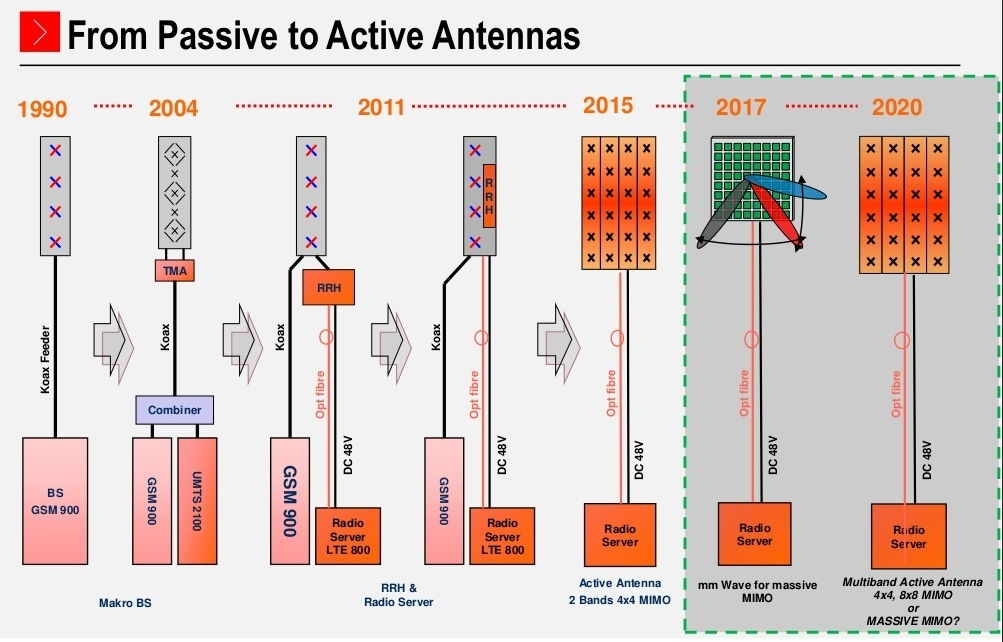1. 5G Antennas
1.1. Short wavelength communications
5G uses what are called “millimeter waves”, or short wavelength radio signals. This requires a new swath of bandwidth that is allocated on the frequency spectrum between 30–300 GHz. This increases the bandwidth available to cram more data and accommodate more users. This will require shorter wavelengths than previous networks, which means they cannot travel longer distances. These signals also cannot easily penetrate through walls and are easily absorbed by moisture and foliage. So why would engineers build a system that cannot travel far and has major drawbacks? That leads to the second feature of 5G (next item).
1.2. Small Cell tower installations
To make sure that signals are able to travel farther without fading, “small cell” towers using a dense deployment will be installed within an area to handle the signaling. They will be much smaller than your typical cellular tower. These small cell towers will be placed within a distance of no less than 200 feet and no more than 1,000 feet apart, so they are pretty close to each other. The advantage to being smaller is that there is more versatility to where they can be installed. They can be put on the side of buildings, utility poles, apartment rooftops just to give a few examples. The small cells then transmit and receive data on the 5G network covering a certain area. So the idea of 5G is replacing high power, low frequency towers with low power, high frequency small cells that communicate with a base station.
1.3. Beamforming Signaling System
To handle data traffic signaling, “beamforming” will be used. It determines the most efficient data delivery route in a 5G network. Beamforming actually sends the data from the small cell directly to the user. Since the signal is more concentrated, it reduces interference as well. Like its predecessor 4G, a 5G network makes use of packet switching over an IP network for data delivery.
1.4. Massive MIMO
MIMO or “Multiple-Input Multiple-Output” allows more signals to be sent and received at any given moment. This is implemented by installing more antennas as an array in a small cell. The problem of having so many antennas installed is addressed by beamforming. With MIMO, a base station can send and receive more signals to boost the capacity of a 5G network by a factor of 22, first reported by engineers at the University of Bristol and Sweden’s Lund University.
1.5. Full Duplex capabilities on the base station
FACT: Wireless providers don’t actually use full-duplex transceivers. In a 5G network, the use of full-duplex will allow data to be transmitted and received on base station transceivers at the same time using the same frequency. Past systems that supported full-duplex communications had to separate frequency channels to allow 2 users to communicate at the same time without having to take turns transmitting and receiving. Now it is possible using just one frequency channel through a circuit design which utilize high speed switching in the silicon. This allows antennas to transmit and receive while the incoming and outgoing signals are routed.
https://hackernoon.com/5g-networks-can-change-the-way-we-live-for-better-or-worse-ed2b3fc6b0e6
2. Main classes of services for 5G TV
| Classes | Original source | Descriptions |
|---|---|---|
| Enhanced Mobile Broadband (eMBB) | 3GPP | Access to multimedia content, services and data by humans |
| Massive Machine Type Communications (mMTC) | 3GPP | Data exchange among low-power devices with minimal throughput and relaxed constraints in terms of delay |
| Ultra-reliable Low Latency Communications (URLLC) | 3GPP | Connectivity with strict levels of availability and latency (autonomous vehicles, public safety, industrial control, robotics and drones, remote medical surgery) |
| Evolved MBMS(Multmedia Broadcast Multicast Service) | extension of the 4G LTE system | Operator can decide to allocate a part of the bandwidth available in downlink in a cell (up to 60%) to broadcast traffic that will serve multiple devices with the same content: video, audio, files, etc. Content delivery is based on MPEG-DASH adaptive streaming but with a single representation or quality level per content. |
3. Technical approaches in 5G Platform
| Classes | Descriptions |
|---|---|
| Network Slicing | Designed to be tuned and dynamically configured in multiple logically partitioned networks with different characteristics and customized QoS levels |
| Fixed wireless access | eMBB enables to distribute high quality content to mobile devices/connected TV/set top boxes in homes with high spectrum efficiency just like traditional TV broadcast terrestrial delivery (currently using DVB-T/T2, ATSC or ISDB-T technologies) |
